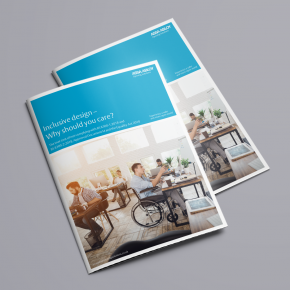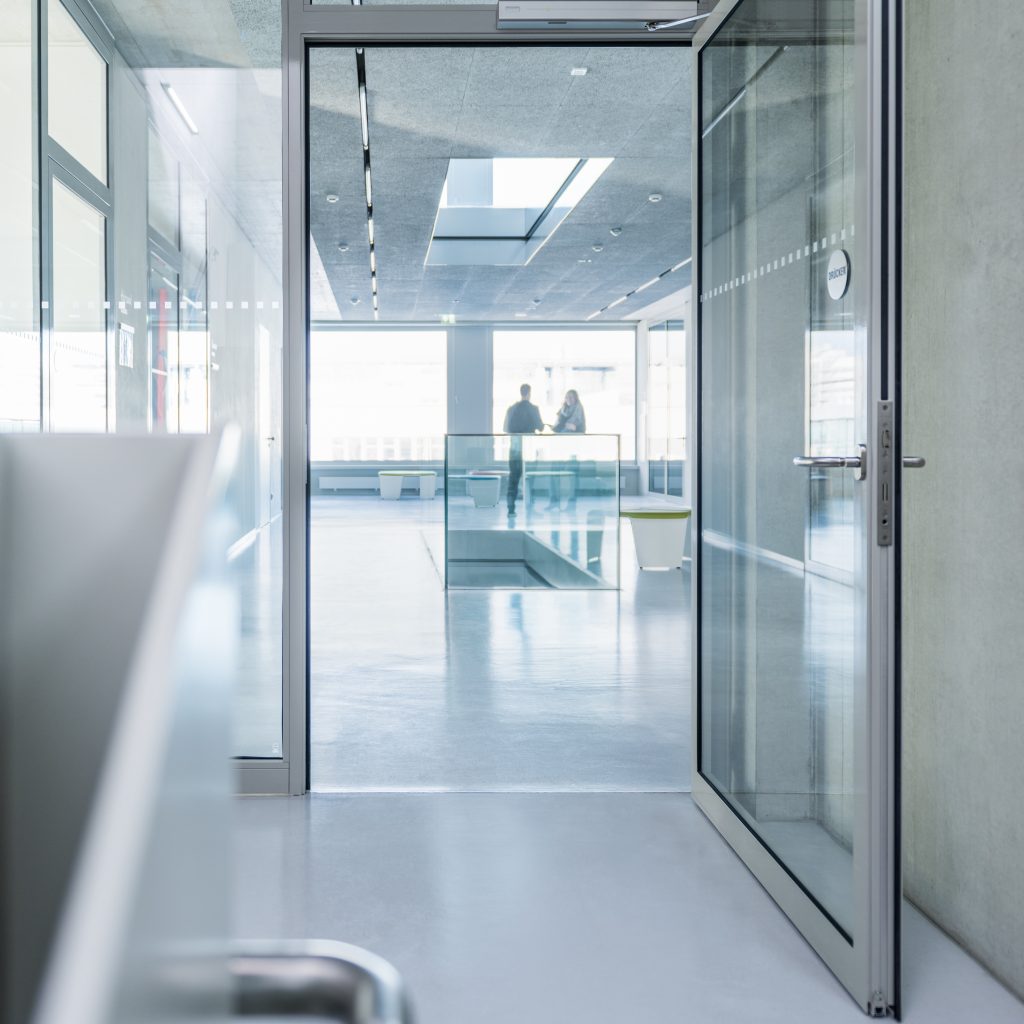
New ASSA ABLOY white paper explains why architects and specifiers should care about inclusive design
With misunderstandings around inclusive design potentially leading to discrimination charges, costly legal disputes and damaged brand reputations, ASSA ABLOY Opening Solutions UK & Ireland has published a free new white paper advising architects and specifiers on the standards door opening solutions need to meet.
Titled Inclusive design – why should you care?, the new white paper can be downloaded by clicking the link; it provides best practice advice on how to ensure door opening solutions can meet the requirements for inclusive building designs, and the risks of not complying with these.
When talking about inclusive design, many people immediately think of those with a disability or specific, specialist requirements. While inclusive design encompasses the needs of these people, its key objective is to make a site inclusive for all, no matter what.
In fact, despite public perception and the wheelchair being the symbol for accessibility, less than 8 per cent of disabilities require the use of a wheelchair[1].
Whether it’s the elderly, disabled or children, everyone should be able to access and use a building and its facilities easily and safely.
Inclusive design is a key consideration for most architects and specifiers today, ensuring any barriers that might prevent an individual from using an environment freely and easily are removed.
This approach must be reviewed in line with the guidelines governing inclusive design, which includes Approved Document M, the Equality Act 2010 and, crucially, BS 8300-1 and 8300-2:2018, which sets out how buildings should be designed, constructed and maintained to create an accessible and inclusive environment for all. It applies to both new builds and refurbishments.

The white paper explains the factors that architects and specifiers need to take into account for door opening solutions to be inclusive.
It also covers some of the common issues with many door opening solutions available on the market, which might claim to comply with standards such as BS 8300-1 and 8300-2:2018 but do not.
For instance, many suppliers will claim to offer compliant solutions by ‘winding down’ a door closer and its spring to power setting EN1. However, while this may help people open a door more easily, it will not provide the necessary closing force.
As a result, the door will not deliver the safety and security assurances demanded of an inclusive environment. It is also important to note that fire doors must have a minimum power setting of EN3 at all times, to meet these needs.
In addition to covering what the guidelines governing inclusive design state for door opening solutions, the white paper advises on how architects and specifiers can ensure these meet the necessary fire safety standards too.
While fire safety has always been critical, incidents such as the Grenfell tragedy have highlighted how this issue can never afford to be an afterthought.
Eryl Jones, MD of the ASSA ABLOY Door Hardware Group, commented: “Inclusive design is viewed by most architects and specifiers nowadays as a non-negotiable.
“While it is the owner that ultimately bears responsibility for the design of a building, should a legal dispute arise then an architect or specifier would be called upon to explain why a solution was recommended.
“In the event of a discrimination claim, those that can demonstrate that they have adhered to standards such as BS 8300-1 and 8300-2:2018 will be on safer ground than those that cannot.

Eryl Jones
“Our new white paper aims to offer architects and specifiers a helpful and informative overview of why inclusive design is so important, what the guidelines governing this state, and the considerations that they need to think about when specifying a door opening solution.
“This means they can be confident when recommending door opening solutions for projects, ensuring everyone – from the elderly to those with a disability and children – can access and use a building and its facilities safely.
“Furthermore, with some architects and specifiers potentially facing clients that might want to do the bare legal minimum when it comes to inclusive design, the white paper also helps outline why the approach is not only the right thing to do from a social point of view, but the impact it can have commercially too.
“Market drivers such as an ageing population and consumer buying power mean brands that prioritise inclusive building design can enjoy greater consumer loyalty and spending opportunities, as well as increased differentiation, credibility and brand awareness.
“We hope that the findings included in the white paper can help support this case for architects and specifiers, when having these conversations with clients.”

Douglas Masterson, Technical Manager at the Guild of Architectural Ironmongers (GAI), added: “It is refreshing in the current climate to see accessibility being placed firmly on the agenda through this white paper.
“At the moment, the headlines are rightly dominated by fire safety – following the Grenfell tragedy – and on-going issues related to the Covid-19 pandemic.
“While these are of huge importance, accessibility must always have room in any discussion relating to the construction industry.
“This paper states ‘all those involved in the design and construction of a building should not simply be working towards inclusivity but demanding it every single time.’ – the GAI is firmly in favour of this statement, and the correct specification of hardware in a building must have the issues of accessibility and inclusive design at its heart.”
Bob Perry, CEO of the Door Hardware Federation (DHF), commented: “It’s really good to see such an important message being highlighted in this white paper.
“Our society is changing – both in its demographics and its attitudes – and it is clear that any company that fails on inclusivity will be left behind. At the same time, however, the requirements around inclusive design are somewhat opaque and there is still much confusion in the industry.
“What this white paper from ASSA ABLOY does is present everything the industry needs to know about the issue.
“It outlines the relevant standards, explains what they really mean, and tells them exactly what they need to do to make sure their door hardware is compliant. On behalf of DHF, I recommend that it is essential reading.”
For more information on ASSA ABLOY Opening Solutions UK & Ireland, visit www.assaabloyopeningsolutions.
Source
[1] Disability Sport, ‘Facts and Figures About Disabled People in the UK’, http://www.disabilitysport.
Contact ASSA ABLOY Opening Solutions EMEA Digital and Access Solutions
Dukes Court/Dukes Street
Woking
GU21 5BH
United Kingdom
Web: About us | ASSA ABLOY
Email: Thomas.schulz@assaabloy.com
Phone: 0049 30 8106 2970
Visit Supplier's page
Latest news

28th March 2025
Ideal Heating Commercial announces 10-year warranty on Evomax 2 boiler
Evomax 2, the UK’s number one selling commercial wall-mounted boiler from Ideal Heating Commercial, is now available with a 10-year warranty.
Posted in Articles, Building Industry News, Building Products & Structures, Building Regulations & Accreditations, Building Services, Facility Management & Building Services, Heating Systems, Controls and Management, Heating, Ventilation and Air Conditioning - HVAC, Innovations & New Products, Pipes, Pipes & Fittings, Plumbing, Retrofit & Renovation, Sustainability & Energy Efficiency, Videos
28th March 2025
FLIR Si1-LD Acoustic Imaging Camera for Compressed Air Leak Detection
FLIR, a Teledyne Technologies company, introduces the Si1-LD, an industrial acoustic imaging camera that brings faster and more accurate compressed air leak detection to those operating on a modest condition monitoring budget.
Posted in Acoustics, Noise & Vibration Control, Articles, Building Industry News, Building Products & Structures, Building Services, Facility Management & Building Services, Information Technology, Innovations & New Products, Retrofit & Renovation, Sustainability & Energy Efficiency, Thermal Imaging and Monitors
28th March 2025
LIFTEX 2025 Seminar programme announced
Registration has opened for LIFTEX 2025. Now in its 37th year, LIFTEX 2025 is the UK’s only dedicated exhibition for the lift, escalator and access industry and takes place only once every three years.
Posted in Access Control & Door Entry Systems, Accessibility, Articles, Building Industry Events, Building Industry News, Building Products & Structures, Building Regulations & Accreditations, Building Services, Exhibitions and Conferences, Facility Management & Building Services, Health & Safety, Retrofit & Renovation, Security and Fire Protection, Seminars
28th March 2025
MCRMA welcomes ArcelorMittal UK to membership
A UK division of the global steelmaking business ArcelorMittal has become the latest new member of the MCRMA, the industry association representing the metal building envelope sector.
Posted in Articles, Building Associations & Institutes, Building Industry News, Building Products & Structures, Building Systems, Cladding, Facades, Posts, Restoration & Refurbishment, Retrofit & Renovation, Roofs, Steel and Structural Frames, Walls
 Sign up:
Sign up: